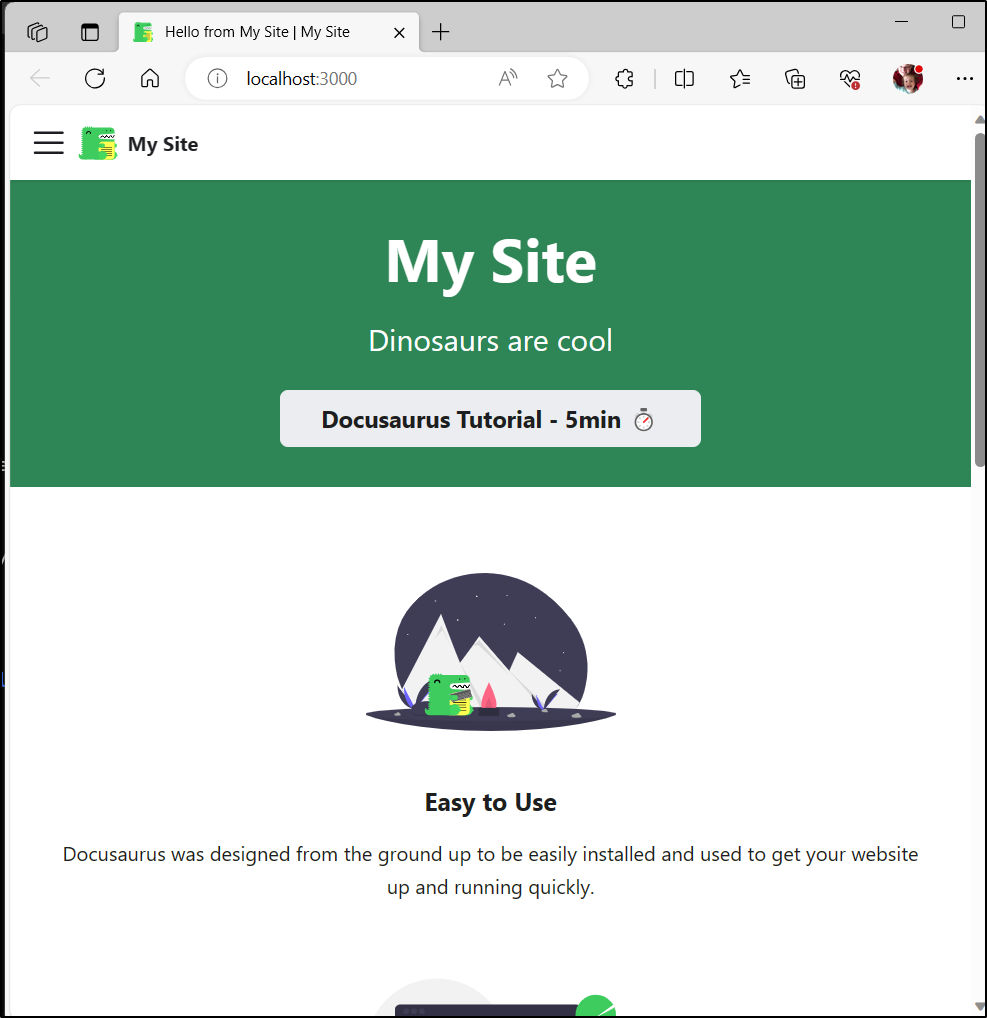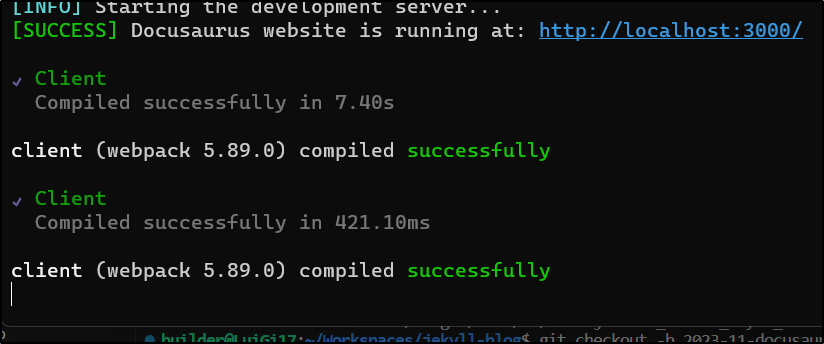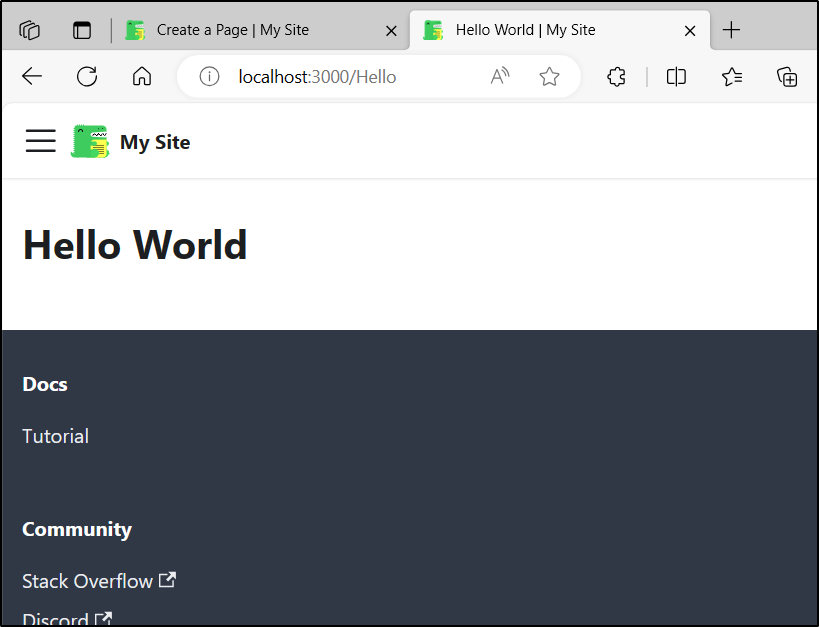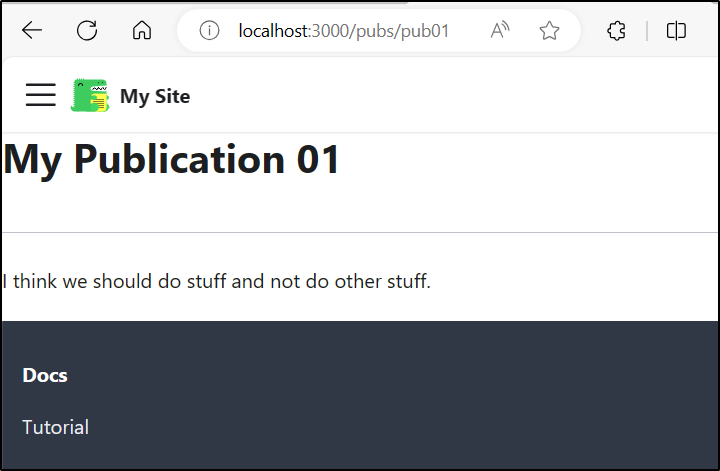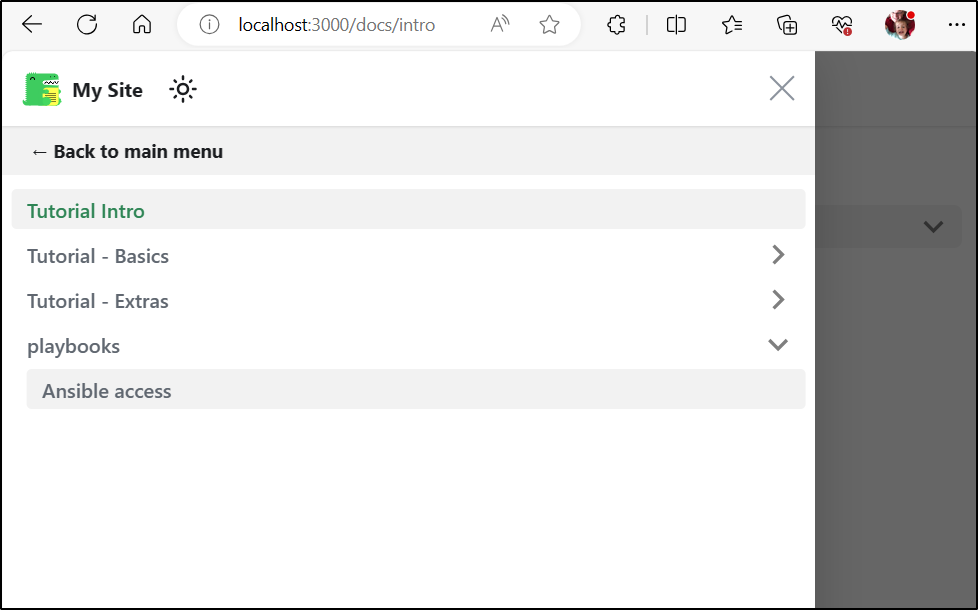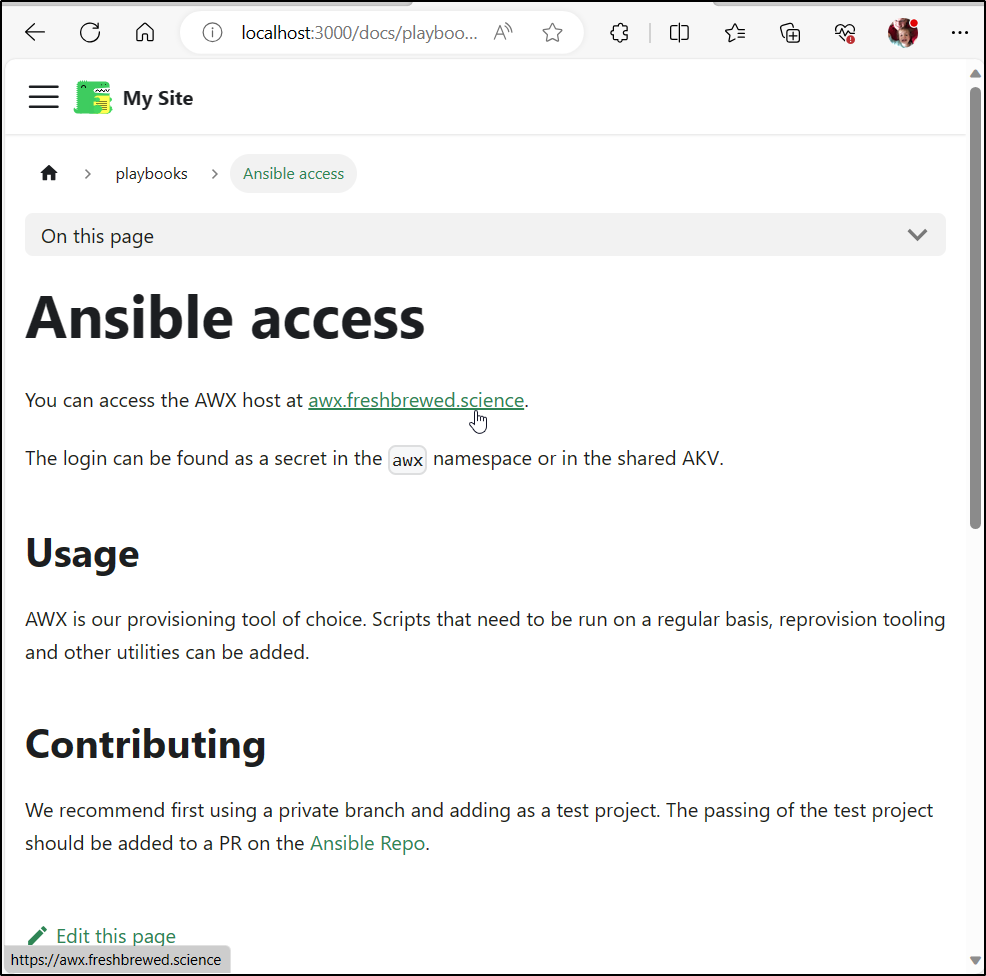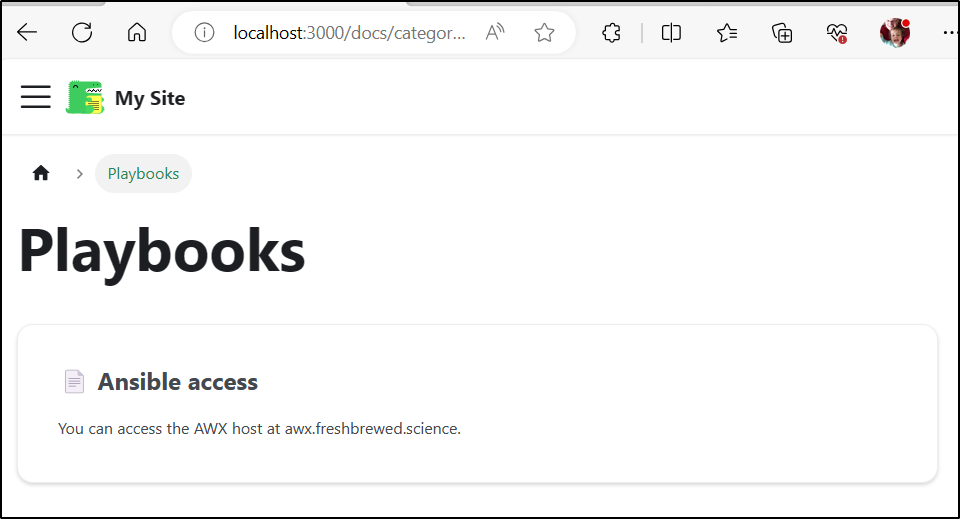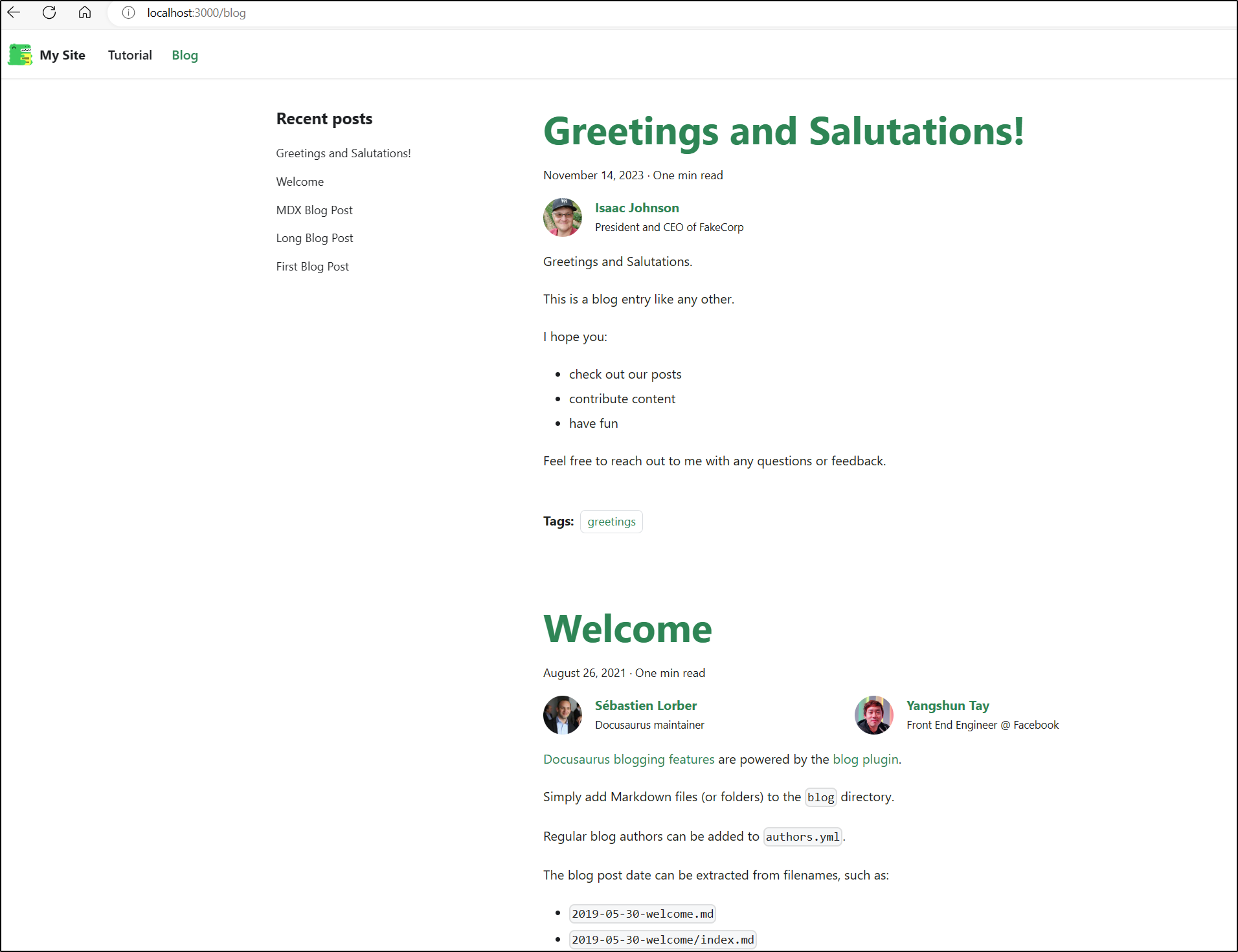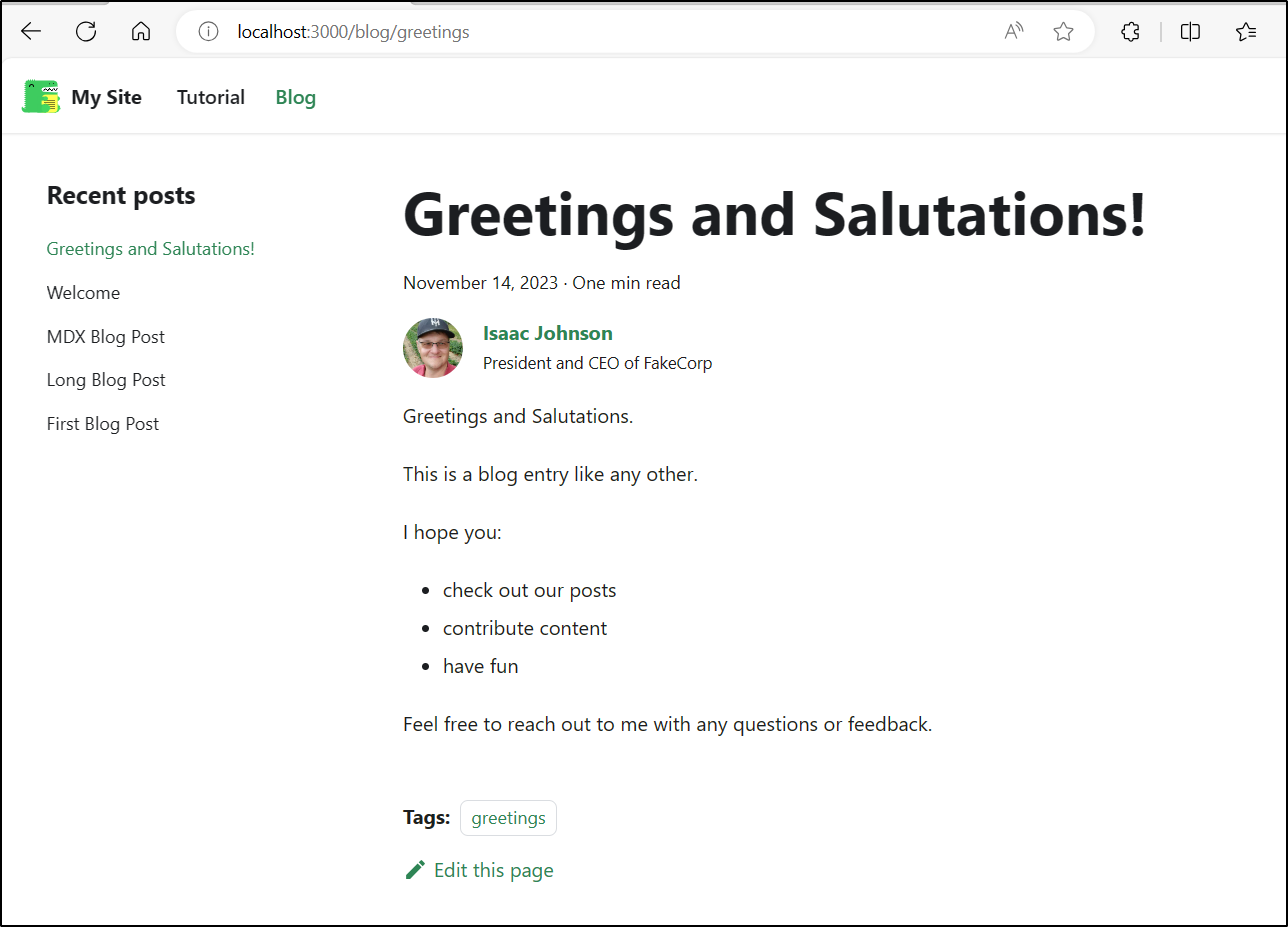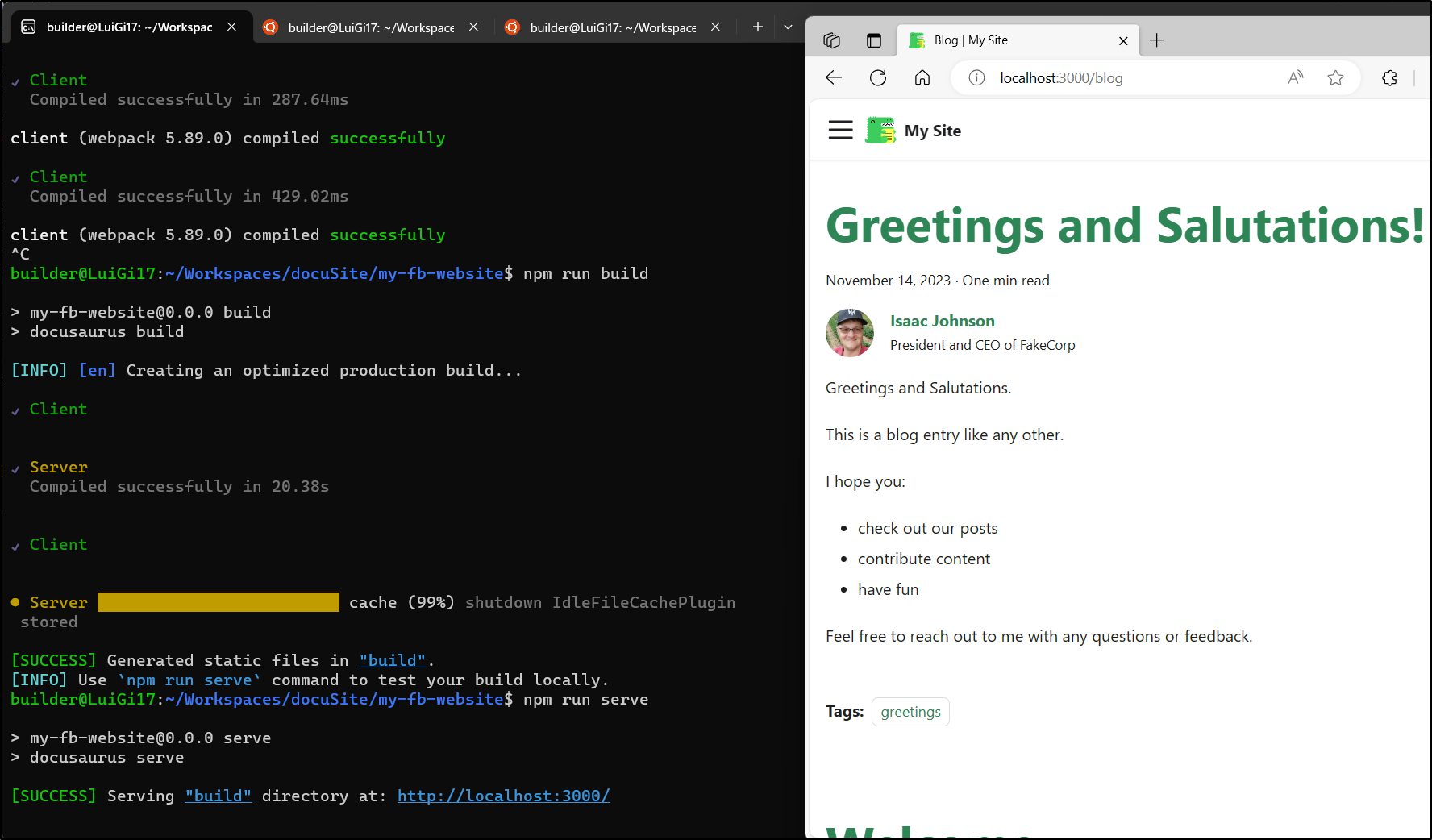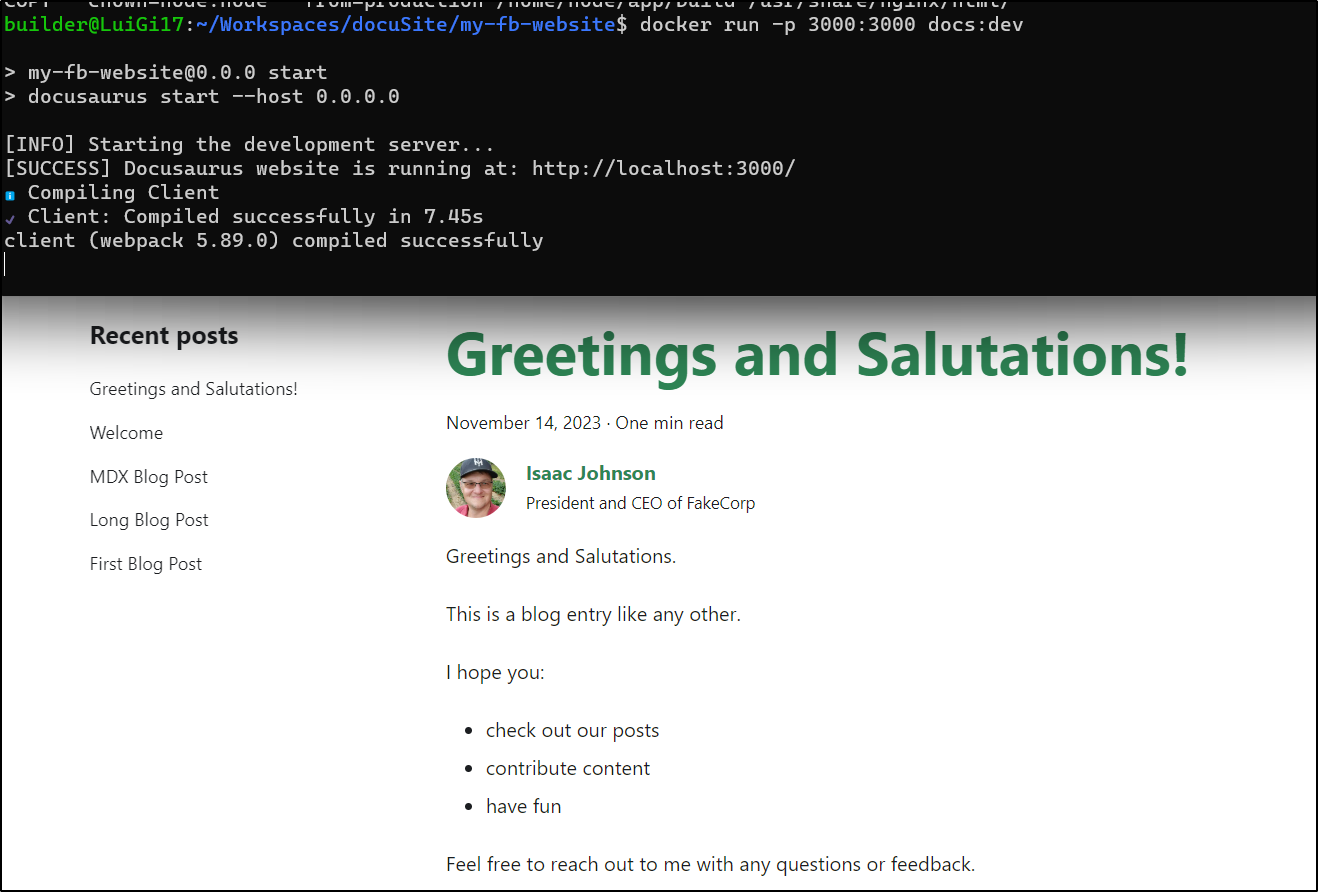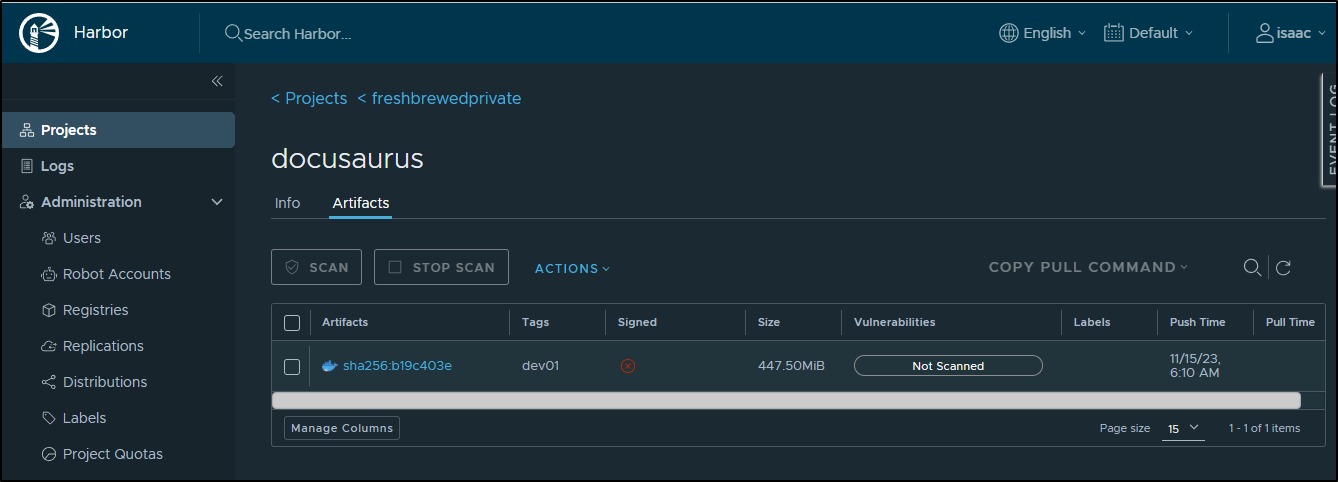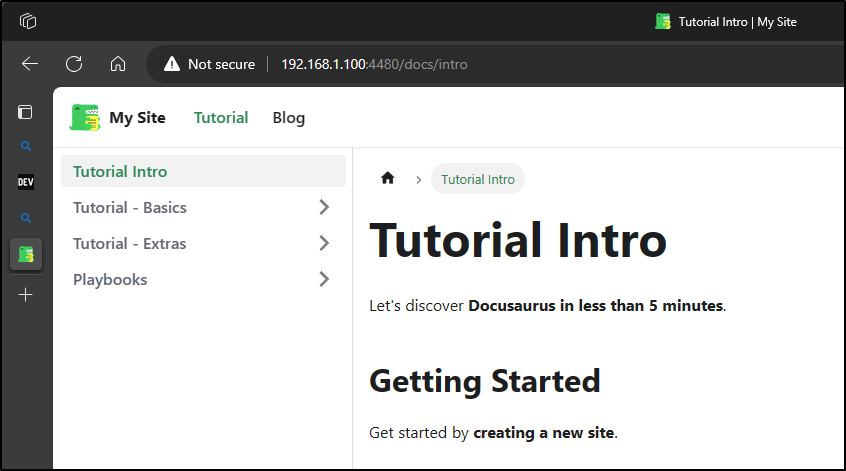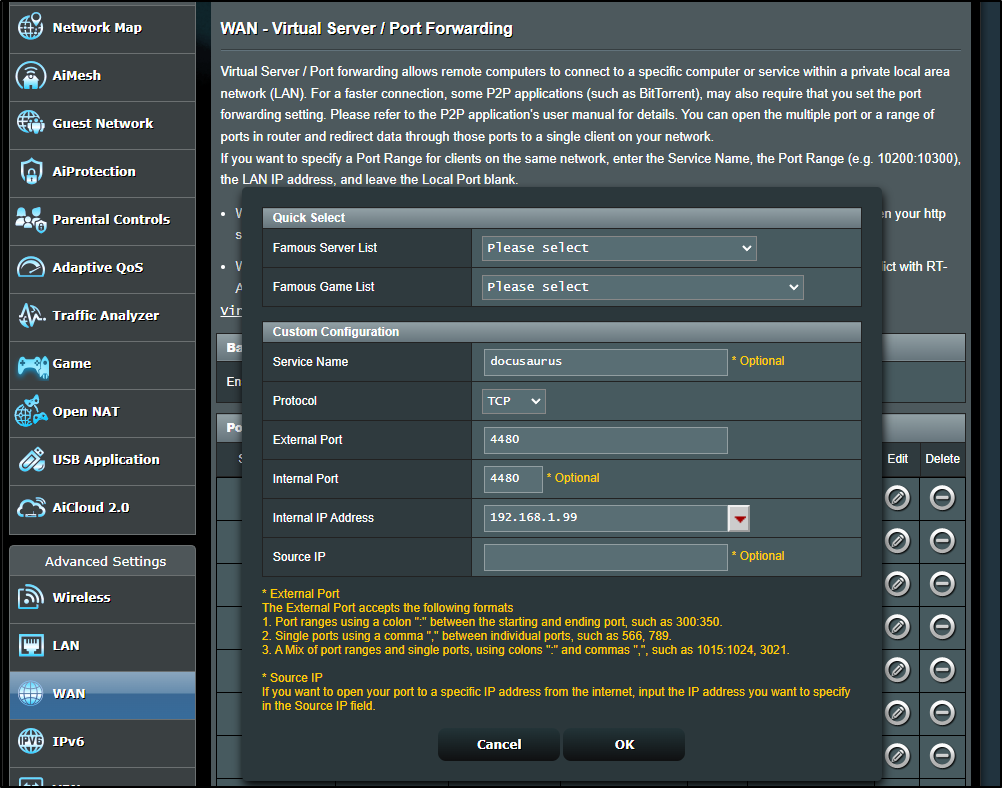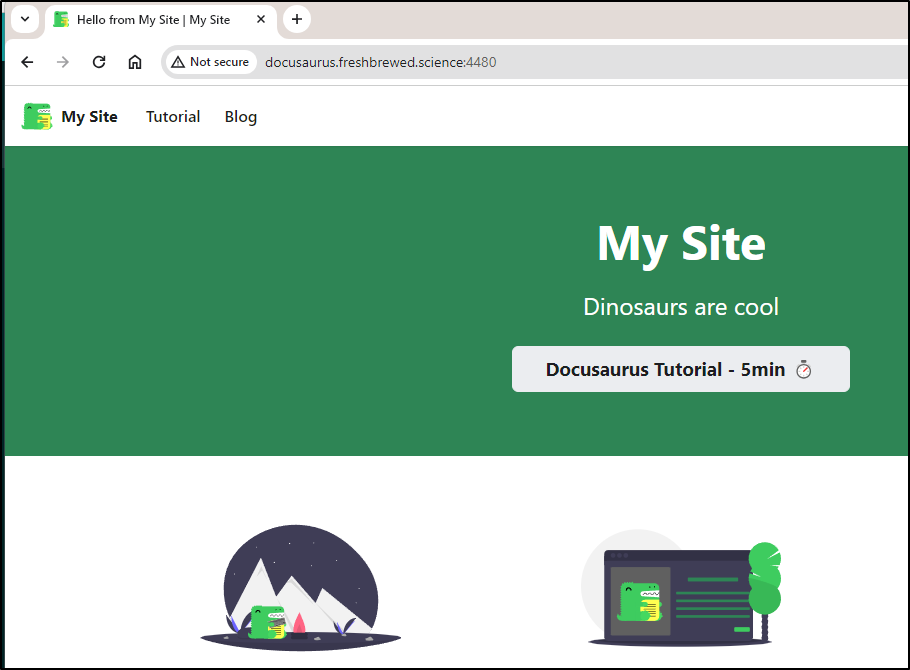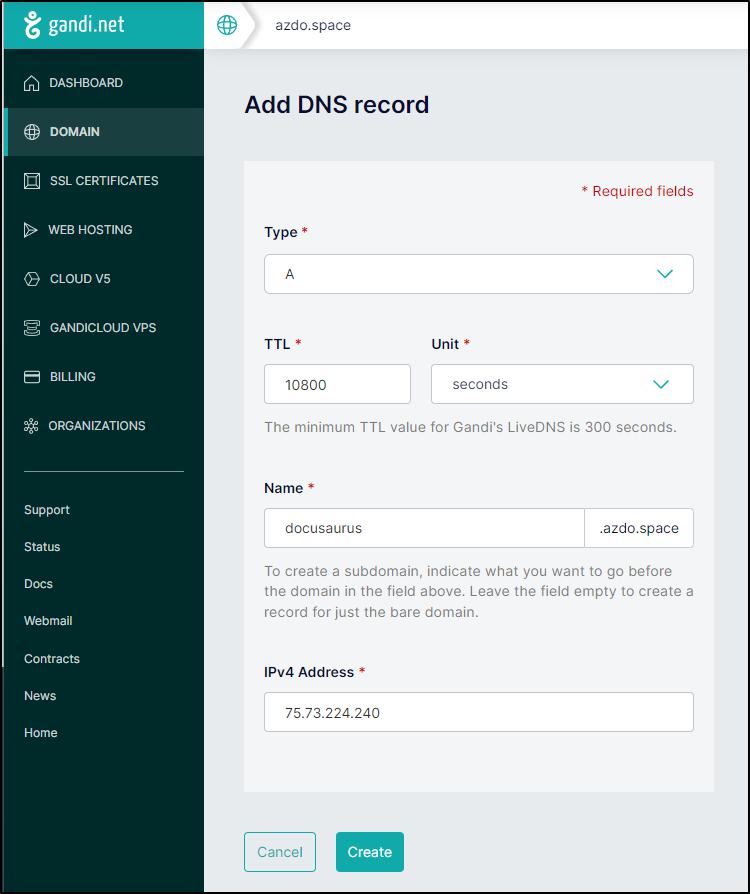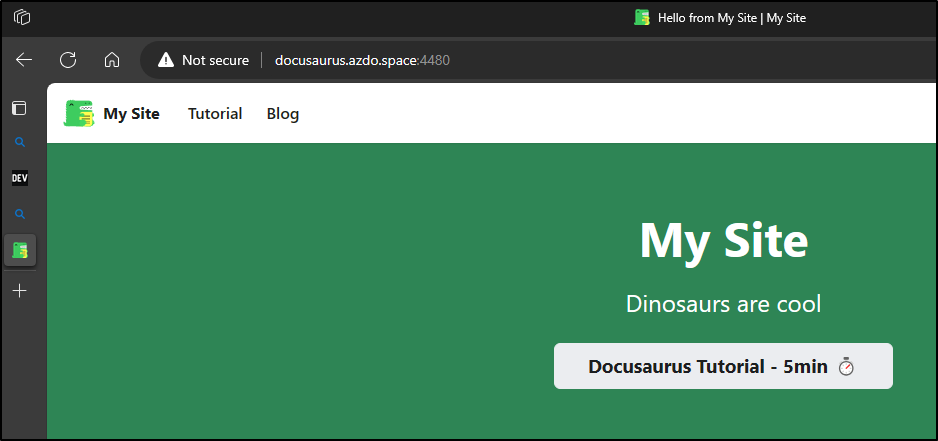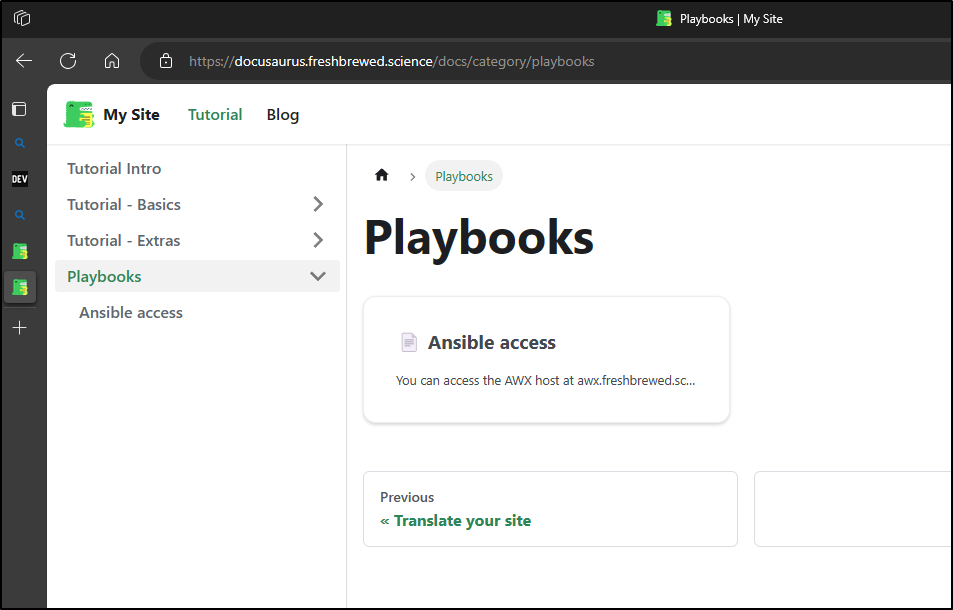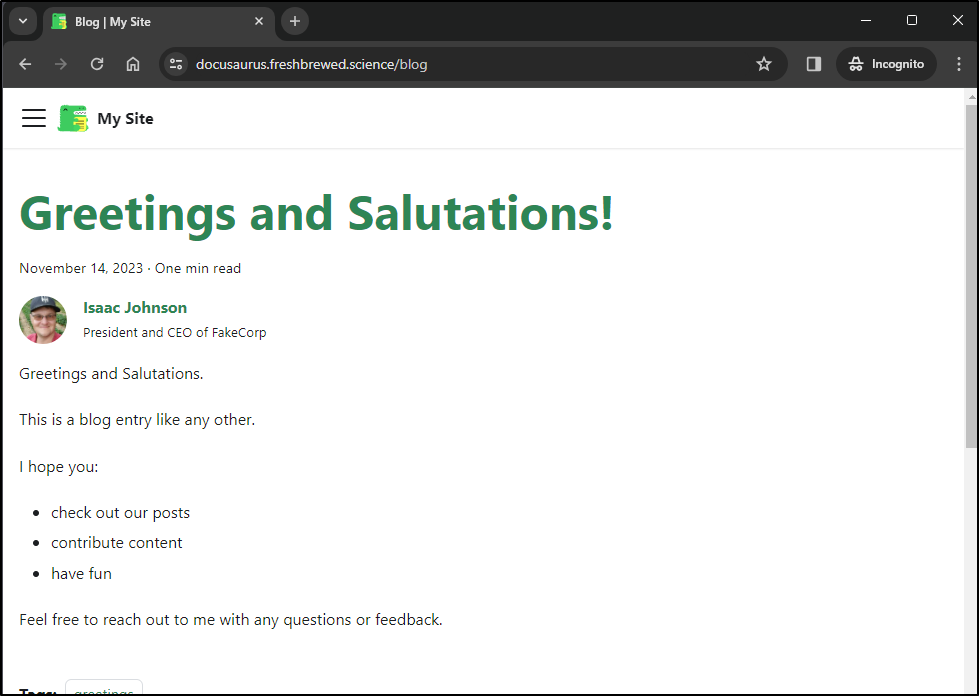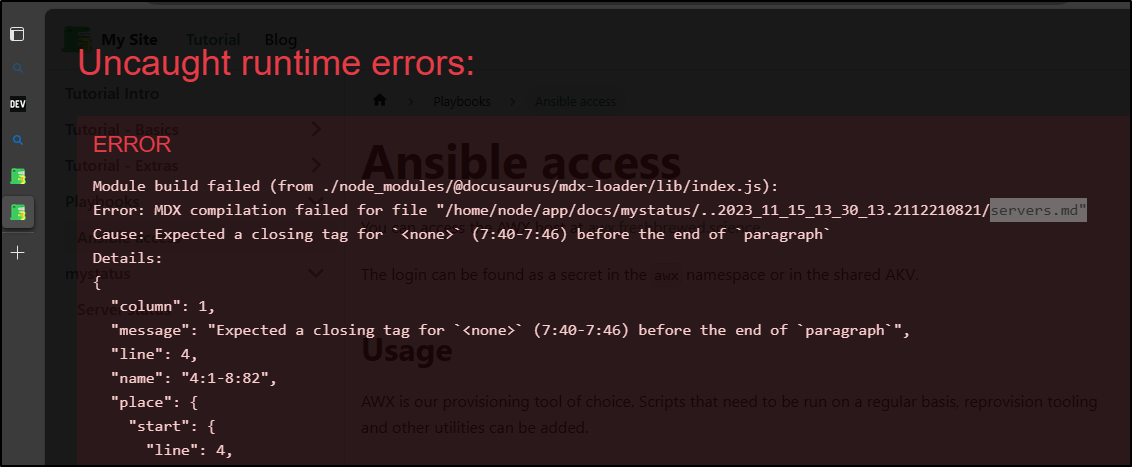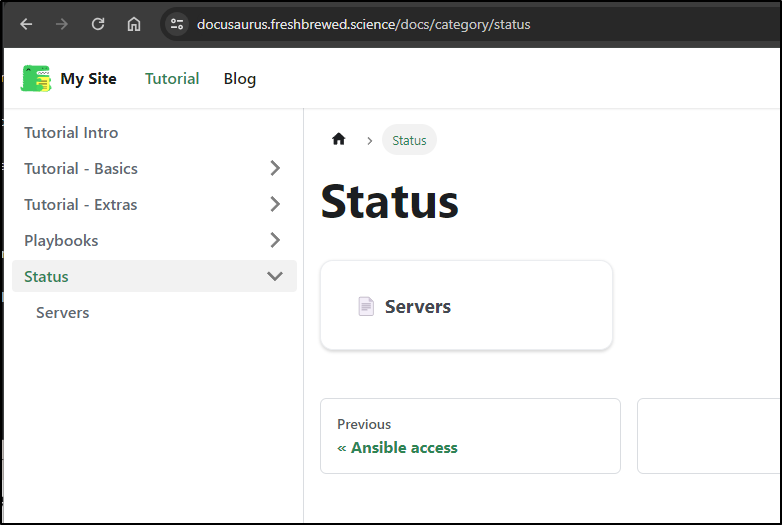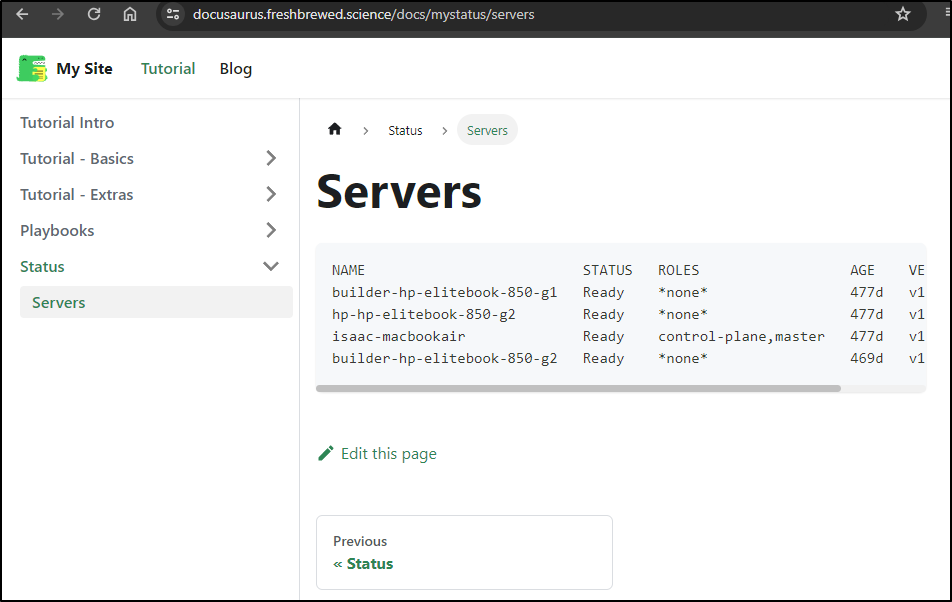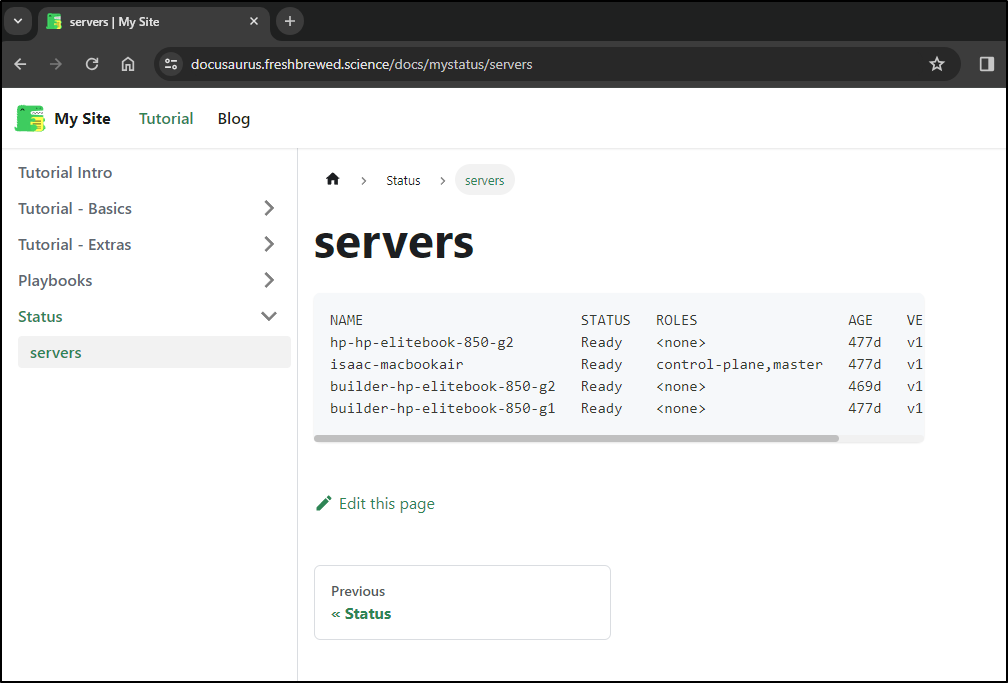Published: Nov 28, 2023 by Isaac Johnson
I recently saw a release announcement for Docusaurus 3.0. It’s a static documentation platform open sourced by Meta. It seemed something worth checking out.
Installation
Let’s start with the most simple usage. We’ll use npx to install it
I’ll make a dir and ensure I’m using a recent NodeJS
builder@LuiGi17:~/Workspaces$ mkdir docuSite
builder@LuiGi17:~/Workspaces$ cd docuSite/
builder@LuiGi17:~/Workspaces/docuSite$ nvm list
v14.21.3
v16.20.2
v18.18.1
-> v18.18.2
v20.8.0
default -> node (-> v20.8.0)
iojs -> N/A (default)
unstable -> N/A (default)
node -> stable (-> v20.8.0) (default)
stable -> 20.8 (-> v20.8.0) (default)
lts/* -> lts/iron (-> N/A)
lts/argon -> v4.9.1 (-> N/A)
lts/boron -> v6.17.1 (-> N/A)
lts/carbon -> v8.17.0 (-> N/A)
lts/dubnium -> v10.24.1 (-> N/A)
lts/erbium -> v12.22.12 (-> N/A)
lts/fermium -> v14.21.3
lts/gallium -> v16.20.2
lts/hydrogen -> v18.18.2
lts/iron -> v20.9.0 (-> N/A)
I’ll fire up an npx command to start the install
builder@LuiGi17:~/Workspaces/docuSite$ npx create-docusaurus@latest my-fb-website classic
Need to install the following packages:
create-docusaurus@3.0.0
Ok to proceed? (y) Y
(#########⠂⠂⠂⠂⠂⠂⠂⠂⠂) ⠹ idealTree:semver: sill placeDep ROOT lru-cache@5.1.1 OK for: @babel/helper-compilation-targets@7.22.15 want:
When the installer is done, we can see some commands
294 packages are looking for funding
run `npm fund` for details
found 0 vulnerabilities
[SUCCESS] Created my-fb-website.
[INFO] Inside that directory, you can run several commands:
`npm start`
Starts the development server.
`npm run build`
Bundles your website into static files for production.
`npm run serve`
Serves the built website locally.
`npm run deploy`
Publishes the website to GitHub pages.
We recommend that you begin by typing:
`cd my-fb-website`
`npm start`
Happy building awesome websites!
I hopped into the dir and tried it
builder@LuiGi17:~/Workspaces/docuSite$ cd my-fb-website/
builder@LuiGi17:~/Workspaces/docuSite/my-fb-website$ ls
README.md babel.config.js blog docs docusaurus.config.js node_modules package-lock.json package.json sidebars.js src static
builder@LuiGi17:~/Workspaces/docuSite/my-fb-website$ npm start
> my-fb-website@0.0.0 start
> docusaurus start
[INFO] Starting the development server...
[SUCCESS] Docusaurus website is running at: http://localhost:3000/
✔ Client
Compiled successfully in 7.40s
client (webpack 5.89.0) compiled successfully
That fired up a sample site
I can now create a page
I see the app auto-reloads when it detected a change:
I can see that echo '# Hello World' > Hello.md indeed created a “Hello” page:
We can also create a React page, perhaps in a subfolder
builder@LuiGi17:~/Workspaces/docuSite/my-fb-website/src/pages$ mkdir pubs
builder@LuiGi17:~/Workspaces/docuSite/my-fb-website/src/pages$ cd pubs
builder@LuiGi17:~/Workspaces/docuSite/my-fb-website/src/pages/pubs$ vi pub01.js
builder@LuiGi17:~/Workspaces/docuSite/my-fb-website/src/pages/pubs$ cat pub01.js
import React from 'react';
import Layout from '@theme/Layout';
export default function MyReactPage() {
return (
<Layout>
<h1>My Publication 01</h1>
<hr/>
<p>I think we should do stuff and not do other stuff.</p>
</Layout>
);
}
Which as one would expect, triggered the app process and we were able to go right to the page
Docs are similar to pages, but they will show up on the left-hand navigation.
Say, for instance, we wanted to build a library of Runbooks for our organization
builder@LuiGi17:~/Workspaces/docuSite/my-fb-website/docs$ mkdir playbooks
builder@LuiGi17:~/Workspaces/docuSite/my-fb-website/docs$ cd playbooks/
builder@LuiGi17:~/Workspaces/docuSite/my-fb-website/docs/playbooks$ vi ansible.md
builder@LuiGi17:~/Workspaces/docuSite/my-fb-website/docs/playbooks$ cat ansible.md
# Ansible access
You can access the AWX host at [awx.freshbrewed.science](https://awx.freshbrewed.science).
The login can be found as a secret in the `awx` namespace or in the shared AKV.
## Usage
AWX is our provisioning tool of choice. Scripts that need to be run on a regular basis, reprovision tooling and other utilities can be added.
## Contributing
We recommend first using a private branch and adding as a test project. The passing of the test project should be added to a PR on the [Ansible Repo](https://github.com/idjohnson/ansible).
I can now see it refreshed in my left hand nav
Which I think would be a pretty functional start
I made the Playbooks area a bit nicer by adding a _category_.json file to generate an index page
builder@LuiGi17:~/Workspaces/docuSite/my-fb-website/docs/playbooks$ cat _category_.json
{
"label": "Playbooks",
"position": 4,
"link": {
"type": "generated-index"
}
}
We now see a landing page:
Blog
We can also use this for a Blog. Let’s add a quick entry
builder@LuiGi17:~/Workspaces/docuSite/my-fb-website/blog$ ls
2019-05-28-first-blog-post.md 2019-05-29-long-blog-post.md 2021-08-01-mdx-blog-post.mdx 2021-08-26-welcome authors.yml
builder@LuiGi17:~/Workspaces/docuSite/my-fb-website/blog$ vi 2023-11-14-salutations.md
builder@LuiGi17:~/Workspaces/docuSite/my-fb-website/blog$ cat 2023-11-14-salutations.md
---
slug: greetings
title: Greetings and Salutations!
authors:
- name: Isaac Johnson
title: President and CEO of FakeCorp
url: https://github.com/idjohnson
image_url: https://avatars.githubusercontent.com/u/6699477?v=4
tags: [greetings]
---
Greetings and Salutations.
This is a blog entry like any other.
I hope you:
- check out our posts
- contribute content
- have fun
Feel free to reach out to me with any questions or feedback.
Unlike the docs or pages, the Blog will add to the top
Though I have the ability to directly to an entry if I want which would be useful for linking
Building the static site
This is really meant to be “built” into a static site.
When I run npm run build I can see it pull everything together
$ npm run build
> my-fb-website@0.0.0 build
> docusaurus build
[INFO] [en] Creating an optimized production build...
✔ Client
✔ Server
Compiled successfully in 20.38s
✔ Client
● Server █████████████████████████ cache (99%) shutdown IdleFileCachePlugin
stored
[SUCCESS] Generated static files in "build".
[INFO] Use `npm run serve` command to test your build locally.
I can easily run npm run serve to now serve the static site. Unlike the app run earlier, this is static, it will not rebuild if we change files. This is mostly to validate the created static site locally
Now we can deploy to Github pages when the time comes. As it stands, it wont
builder@LuiGi17:~/Workspaces/docuSite/my-fb-website$ npm run deploy
> my-fb-website@0.0.0 deploy
> docusaurus deploy
[WARNING] When deploying to GitHub Pages, it is better to use an explicit "trailingSlash" site config.
Otherwise, GitHub Pages will add an extra trailing slash to your site urls only on direct-access (not when navigation) with a server redirect.
This behavior can have SEO impacts and create relative link issues.
[INFO] Deploy command invoked...
Error: Please set the GIT_USER environment variable, or explicitly specify USE_SSH instead!
at Command.deploy (/home/builder/Workspaces/docuSite/my-fb-website/node_modules/@docusaurus/core/lib/commands/deploy.js:70:19)
[INFO] Docusaurus version: 3.0.0
Node version: v18.18.2
builder@LuiGi17:~/Workspaces/docuSite/my-fb-website$
Dockerfile
If we want to expose this using Docker, we need to tweak the package.json to start the app with all hosts allowed (0.0.0.0):
You need to set the host allow to 0.0.0.0
builder@LuiGi17:~/Workspaces/docuSite/my-fb-website$ cat package.json | grep 0.0.0.0
"start": "docusaurus start --host 0.0.0.0",
"serve": "docusaurus serve --host 0.0.0.0",
We can then create a Dockerfile that will serve Dev and Production. I found this on a blog article on dev.to, just to give proper credit.
builder@LuiGi17:~/Workspaces/docuSite/my-fb-website$ cat Dockerfile
## Base ########################################################################
# Use a larger node image to do the build for native deps (e.g., gcc, python)
FROM node:lts as base
# Reduce npm log spam and colour during install within Docker
ENV NPM_CONFIG_LOGLEVEL=warn
ENV NPM_CONFIG_COLOR=false
# We'll run the app as the `node` user, so put it in their home directory
WORKDIR /home/node/app
# Copy the source code over
COPY --chown=node:node . /home/node/app/
## Development #################################################################
# Define a development target that installs devDeps and runs in dev mode
FROM base as development
WORKDIR /home/node/app
# Install (not ci) with dependencies, and for Linux vs. Linux Musl (which we use for -alpine)
RUN npm install
# Switch to the node user vs. root
USER node
# Expose port 3000
EXPOSE 3000
# Start the app in debug mode so we can attach the debugger
CMD ["npm", "start"]
## Production ##################################################################
# Also define a production target which doesn't use devDeps
FROM base as production
WORKDIR /home/node/app
COPY --chown=node:node --from=development /home/node/app/node_modules /home/node/app/node_modules
# Build the Docusaurus app
RUN npm run build
## Deploy ######################################################################
# Use a stable nginx image
FROM nginx:stable-alpine as deploy
WORKDIR /home/node/app
# Copy what we've installed/built from production
COPY --chown=node:node --from=production /home/node/app/build /usr/share/nginx/html/
I can build it:
builder@LuiGi17:~/Workspaces/docuSite/my-fb-website$ docker build --target development -t docs:dev .
[+] Building 74.5s (11/11) FINISHED docker:default
=> [internal] load build definition from Dockerfile 0.1s
=> => transferring dockerfile: 1.61kB 0.0s
=> [internal] load .dockerignore 0.1s
=> => transferring context: 2B 0.0s
=> [internal] load metadata for docker.io/library/node:lts 2.6s
=> [auth] library/node:pull token for registry-1.docker.io 0.0s
=> [base 1/3] FROM docker.io/library/node:lts@sha256:5f21943fe97b24ae1740da6d7b9c56ac43fe3495acb47c1b232b0a352b02a25c 62.7s
=> => resolve docker.io/library/node:lts@sha256:5f21943fe97b24ae1740da6d7b9c56ac43fe3495acb47c1b232b0a352b02a25c 0.0s
=> => sha256:5f21943fe97b24ae1740da6d7b9c56ac43fe3495acb47c1b232b0a352b02a25c 1.21kB / 1.21kB 0.0s
=> => sha256:cb7cd40ba6483f37f791e1aace576df449fc5f75332c19ff59e2c6064797160e 2.00kB / 2.00kB 0.0s
=> => sha256:b5288ff94366c7c413f66f967629c66876f22de02bae58f0c0cba2fa42eb292b 7.52kB / 7.52kB 0.0s
=> => sha256:325c5bf4c2f26c11380501bec4b6eef8a3ea35b554aa1b222cbcd1e1fe11ae1d 64.13MB / 64.13MB 21.2s
=> => sha256:8457fd5474e70835e4482983a5662355d892d5f6f0f90a27a8e9f009997e8196 49.58MB / 49.58MB 21.7s
=> => sha256:13baa2029dde87a21b87127168a0fb50a007c07da6b5adc8864e1fe1376c86ff 24.05MB / 24.05MB 11.4s
=> => sha256:7e18a660069fd7f87a7a6c49ddb701449bfb929c066811777601d36916c7f674 211.06MB / 211.06MB 51.5s
=> => sha256:c30e0acec6d561f6ec4e8d3ccebdeedbe505923a613afe3df4a6ea0a40f2240a 3.37kB / 3.37kB 21.3s
=> => sha256:6b06d99eb2a57636421f94780405fdc53fc8159cf7991fca61edb9a4565b234f 47.84MB / 47.84MB 37.8s
=> => extracting sha256:8457fd5474e70835e4482983a5662355d892d5f6f0f90a27a8e9f009997e8196 3.1s
=> => sha256:a3e4c4d8a88e065a9b9ed4634fafd6b3064ea8a673efbf8ecc046038c73363ef 2.21MB / 2.21MB 22.9s
=> => sha256:9dbab0291c0e40e9c4172533b5c8c74c1f7b24b50c6973b45c687d1d5f086679 452B / 452B 23.1s
=> => extracting sha256:13baa2029dde87a21b87127168a0fb50a007c07da6b5adc8864e1fe1376c86ff 0.8s
=> => extracting sha256:325c5bf4c2f26c11380501bec4b6eef8a3ea35b554aa1b222cbcd1e1fe11ae1d 3.5s
=> => extracting sha256:7e18a660069fd7f87a7a6c49ddb701449bfb929c066811777601d36916c7f674 7.5s
=> => extracting sha256:c30e0acec6d561f6ec4e8d3ccebdeedbe505923a613afe3df4a6ea0a40f2240a 0.0s
=> => extracting sha256:6b06d99eb2a57636421f94780405fdc53fc8159cf7991fca61edb9a4565b234f 2.7s
=> => extracting sha256:a3e4c4d8a88e065a9b9ed4634fafd6b3064ea8a673efbf8ecc046038c73363ef 0.1s
=> => extracting sha256:9dbab0291c0e40e9c4172533b5c8c74c1f7b24b50c6973b45c687d1d5f086679 0.0s
=> [internal] load build context 6.6s
=> => transferring context: 271.88MB 6.4s
=> [base 2/3] WORKDIR /home/node/app 0.3s
=> [base 3/3] COPY --chown=node:node . /home/node/app/ 2.7s
=> [development 1/2] WORKDIR /home/node/app 0.1s
=> [development 2/2] RUN npm install 2.5s
=> exporting to image 3.3s
=> => exporting layers 3.2s
=> => writing image sha256:be3e9fdcf98f6ebb6e862c80256d51bef42b469f087470a4a1a49a0baecbd3a4 0.0s
=> => naming to docker.io/library/docs:dev 0.0s
What's Next?
View a summary of image vulnerabilities and recommendations → docker scout quickview
Then run it
$ docker run -p 3000:3000 docs:dev
> my-fb-website@0.0.0 start
> docusaurus start --host 0.0.0.0
[INFO] Starting the development server...
[SUCCESS] Docusaurus website is running at: http://localhost:3000/
ℹ Compiling Client
✔ Client: Compiled successfully in 7.45s
client (webpack 5.89.0) compiled successfully
As you can see in the Dockerfile, the real difference between “Development” and “Production” is really about building static files or running the app
## Development #################################################################
# Define a development target that installs devDeps and runs in dev mode
FROM base as development
WORKDIR /home/node/app
# Install (not ci) with dependencies, and for Linux vs. Linux Musl (which we use for -alpine)
RUN npm install
# Switch to the node user vs. root
USER node
# Expose port 3000
EXPOSE 3000
# Start the app in debug mode so we can attach the debugger
CMD ["npm", "start"]
## Production ##################################################################
# Also define a production target which doesn't use devDeps
FROM base as production
WORKDIR /home/node/app
COPY --chown=node:node --from=development /home/node/app/node_modules /home/node/app/node_modules
# Build the Docusaurus app
RUN npm run build
## Deploy ######################################################################
# Use a stable nginx image
FROM nginx:stable-alpine as deploy
WORKDIR /home/node/app
# Copy what we've installed/built from production
COPY --chown=node:node --from=production /home/node/app/build /usr/share/nginx/html/
Kubernetes
Of course, I’ll want to host this outside of a local docker. I could put the docker container on a Docker host and serve it up there. I could also create a deployment that I update. An advantage of Kubernetes, is that I can later take the docs folder and turn it into a configmap mount that I update on the fly.
Let’s start with Docker host path first, then work our way to K8s.
I’ll build with a more proper tag (I could just point a tag to a tag, but I moved hosts so I need to rebuild anyhow)
$ docker build --target development -t docusaurus:dev01 .
[+] Building 29.9s (10/10) FINISHED
=> [internal] load build definition from Dockerfile 0.0s
=> => transferring dockerfile: 1.62kB 0.0s
=> [internal] load .dockerignore 0.0s
=> => transferring context: 2B 0.0s
=> [internal] load metadata for docker.io/library/node:lts 1.8s
=> [base 1/3] FROM docker.io/library/node:lts@sha256:5f21943fe97b24ae1740da6d7b9c56ac43fe3495acb47c 11.5s
=> => resolve docker.io/library/node:lts@sha256:5f21943fe97b24ae1740da6d7b9c56ac43fe3495acb47c1b232b 0.0s
=> => sha256:cb7cd40ba6483f37f791e1aace576df449fc5f75332c19ff59e2c6064797160e 2.00kB / 2.00kB 0.0s
=> => sha256:5f21943fe97b24ae1740da6d7b9c56ac43fe3495acb47c1b232b0a352b02a25c 1.21kB / 1.21kB 0.0s
=> => sha256:b5288ff94366c7c413f66f967629c66876f22de02bae58f0c0cba2fa42eb292b 7.52kB / 7.52kB 0.0s
=> => sha256:8457fd5474e70835e4482983a5662355d892d5f6f0f90a27a8e9f009997e8196 49.58MB / 49.58MB 1.0s
=> => sha256:13baa2029dde87a21b87127168a0fb50a007c07da6b5adc8864e1fe1376c86ff 24.05MB / 24.05MB 3.0s
=> => sha256:325c5bf4c2f26c11380501bec4b6eef8a3ea35b554aa1b222cbcd1e1fe11ae1d 64.13MB / 64.13MB 3.8s
=> => sha256:7e18a660069fd7f87a7a6c49ddb701449bfb929c066811777601d36916c7f674 211.06MB / 211.06MB 4.8s
=> => extracting sha256:8457fd5474e70835e4482983a5662355d892d5f6f0f90a27a8e9f009997e8196 1.2s
=> => extracting sha256:13baa2029dde87a21b87127168a0fb50a007c07da6b5adc8864e1fe1376c86ff 0.4s
=> => sha256:c30e0acec6d561f6ec4e8d3ccebdeedbe505923a613afe3df4a6ea0a40f2240a 3.37kB / 3.37kB 3.5s
=> => sha256:6b06d99eb2a57636421f94780405fdc53fc8159cf7991fca61edb9a4565b234f 47.84MB / 47.84MB 5.6s
=> => extracting sha256:325c5bf4c2f26c11380501bec4b6eef8a3ea35b554aa1b222cbcd1e1fe11ae1d 1.5s
=> => sha256:a3e4c4d8a88e065a9b9ed4634fafd6b3064ea8a673efbf8ecc046038c73363ef 2.21MB / 2.21MB 4.1s
=> => sha256:9dbab0291c0e40e9c4172533b5c8c74c1f7b24b50c6973b45c687d1d5f086679 452B / 452B 4.2s
=> => extracting sha256:7e18a660069fd7f87a7a6c49ddb701449bfb929c066811777601d36916c7f674 4.0s
=> => extracting sha256:c30e0acec6d561f6ec4e8d3ccebdeedbe505923a613afe3df4a6ea0a40f2240a 0.0s
=> => extracting sha256:6b06d99eb2a57636421f94780405fdc53fc8159cf7991fca61edb9a4565b234f 1.2s
=> => extracting sha256:a3e4c4d8a88e065a9b9ed4634fafd6b3064ea8a673efbf8ecc046038c73363ef 0.1s
=> => extracting sha256:9dbab0291c0e40e9c4172533b5c8c74c1f7b24b50c6973b45c687d1d5f086679 0.0s
=> [internal] load build context 1.4s
=> => transferring context: 1.36MB 1.2s
=> [base 2/3] WORKDIR /home/node/app 1.7s
=> [base 3/3] COPY --chown=node:node . /home/node/app/ 0.1s
=> [development 1/2] WORKDIR /home/node/app 0.0s
=> [development 2/2] RUN npm install 11.3s
=> exporting to image 3.4s
=> => exporting layers 3.4s
=> => writing image sha256:06a14264f55ed413fce19ccd6e60d0244af8222aefbae06925e0c727e9a706e3 0.0s
=> => naming to docker.io/library/docusaurus:dev01 0.0s
I’ll tag to my Harbor CR
$ docker tag docusaurus:dev01 harbor.freshbrewed.science/freshbrewedprivate/docusaurus:dev01
Then push it
$ docker push harbor.freshbrewed.science/freshbrewedprivate/docusaurus:dev01
The push refers to repository [harbor.freshbrewed.science/freshbrewedprivate/docusaurus]
fdf4034f00a3: Pushed
5f70bf18a086: Mounted from freshbrewedprivate/pubsub-python-subscriber
aca7e72fa4e4: Pushed
0966a7a329d3: Pushed
722019bfb882: Pushed
de9aa01d609b: Pushed
fb9679ec7cc7: Pushed
ccd778ffcca1: Pushed
12b956927ba2: Pushed
266def75d28e: Pushed
29e49b59edda: Pushed
1777ac7d307b: Pushed
dev01: digest: sha256:b19c403e337e056d7dc2a5f6093330d7c6ae5a57e7be1d8e51c6c6c28ca05159 size: 2839
If you don’t have a Harbor CR to use, you could use Dockerhub or any other Container Registry. As it stands, the image is about 450Mb
Next, I’ll hop over to my container runner box (which, if curious, is a little SkyBarium Mini PC which runs a few containerized services already).
builder@builder-T100:~$ docker ps
CONTAINER ID IMAGE COMMAND CREATED STATUS PORTS NAMES
1f3ada372a43 darthsim/imgproxy:v3.8.0 "imgproxy" 9 days ago Up 9 days (healthy) 8080/tcp supabase-imgproxy
26e4f801ed15 timberio/vector:0.28.1-alpine "/usr/local/bin/vect…" 9 days ago Up 9 days (healthy) supabase-vector
8ed93813eeca rundeck/rundeck:4.17.1 "/tini -- docker-lib…" 3 weeks ago Up 3 weeks 0.0.0.0:5440->4440/tcp, :::5440->4440/tcp rundeck4
1700cf832175 louislam/uptime-kuma:1.23.3 "/usr/bin/dumb-init …" 3 weeks ago Up 3 weeks (healthy) 0.0.0.0:3101->3001/tcp, :::3101->3001/tcp uptime-kuma-1233b
767c9377f238 rundeck/rundeck:3.4.6 "/tini -- docker-lib…" 6 months ago Up 3 months 0.0.0.0:4440->4440/tcp, :::4440->4440/tcp rundeck2
Oddly, I found when I build this container fresh, it really wanted to write to a dir to which it didnt have permissions
builder@builder-T100:~$ docker run -p 4480:3000 --name docusaurustest harbor.freshbrewed.science/freshbrewedprivate/docusaurus:dev01
> my-fb-website@0.0.0 start
> docusaurus start --host 0.0.0.0
[INFO] Starting the development server...
[Error: EACCES: permission denied, mkdir '/home/node/app/.docusaurus'] {
errno: -13,
code: 'EACCES',
syscall: 'mkdir',
path: '/home/node/app/.docusaurus'
}
[INFO] Docusaurus version: 3.0.0
Node version: v20.9.0
npm notice
npm notice New minor version of npm available! 10.1.0 -> 10.2.3
npm notice Changelog: <https://github.com/npm/cli/releases/tag/v10.2.3>
npm notice Run `npm install -g npm@10.2.3` to update!
npm notice
I tried a volume, but that didn’t solve it either
builder@builder-T100:~$ docker volume create docutest01
docutest01
builder@builder-T100:~$ docker run -p 4480:3000 -v docutest01:/home/node/app --name docusaurustest harbor.freshbrewed.science/freshbrewedprivate/docusaurus:dev01
> my-fb-website@0.0.0 start
> docusaurus start --host 0.0.0.0
[INFO] Starting the development server...
[Error: EACCES: permission denied, mkdir '/home/node/app/.docusaurus'] {
errno: -13,
code: 'EACCES',
syscall: 'mkdir',
path: '/home/node/app/.docusaurus'
}
[INFO] Docusaurus version: 3.0.0
Node version: v20.9.0
npm notice
npm notice New minor version of npm available! 10.1.0 -> 10.2.3
npm notice Changelog: <https://github.com/npm/cli/releases/tag/v10.2.3>
npm notice Run `npm install -g npm@10.2.3` to update!
npm notice
I cannot explain why new builds turfed dir permissions.
After some local debugging, I fixed it by adding a RUN chown -R node:node /home/node/ line to the Dockerfile
$ cat Dockerfile
## Base ########################################################################
# Use a larger node image to do the build for native deps (e.g., gcc, python)
FROM node:lts as base
ENV GROUP_ID=1000 \
USER_ID=1000
# Reduce npm log spam and colour during install within Docker
ENV NPM_CONFIG_LOGLEVEL=warn
ENV NPM_CONFIG_COLOR=false
#USER root
#RUN addgroup --gid $GROUP_ID node
#RUN adduser -D --uid $USER_ID -G node node
# We'll run the app as the `node` user, so put it in their home directory
WORKDIR /home/node/app
# Copy the source code over
COPY --chown=node:node . /home/node/app/
## Development #################################################################
# Define a development target that installs devDeps and runs in dev mode
FROM base as development
WORKDIR /home/node/app
# Install (not ci) with dependencies, and for Linux vs. Linux Musl (which we use for -alpine)
RUN npm install
# Switch to the node user vs. root
RUN chown -R node:node /home/node/
USER node
# Expose port 3000
EXPOSE 3000
# Start the app in debug mode so we can attach the debugger
CMD ["npm", "start"]
## Production ##################################################################
# Also define a production target which doesn't use devDeps
FROM base as production
WORKDIR /home/node/app
COPY --chown=node:node --from=development /home/node/app/node_modules /home/node/app/node_modules
# Build the Docusaurus app
RUN npm run build
## Deploy ######################################################################
# Use a stable nginx image
FROM nginx:stable-alpine as deploy
WORKDIR /home/node/app
# Copy what we've installed/built from production
COPY --chown=node:node --from=production /home/node/app/build /usr/share/nginx/html/
I pushed from the local PC and pulled down to test on the Docker host
builder@DESKTOP-QADGF36:~/Workspaces/MyFbWebsite$ docker tag docs:dev3 harbor.freshbrewed.science/freshbrewedprivate/docusaurus:dev03
builder@DESKTOP-QADGF36:~/Workspaces/MyFbWebsite$ docker push harbor.freshbrewed.science/freshbrewedprivate/docusaurus:dev03
The push refers to repository [harbor.freshbrewed.science/freshbrewedprivate/docusaurus]
d46521f7d43a: Pushed
368221442350: Pushed
5f70bf18a086: Layer already exists
743e79bd500d: Pushed
0966a7a329d3: Layer already exists
722019bfb882: Layer already exists
de9aa01d609b: Layer already exists
fb9679ec7cc7: Layer already exists
ccd778ffcca1: Layer already exists
12b956927ba2: Layer already exists
266def75d28e: Layer already exists
29e49b59edda: Layer already exists
1777ac7d307b: Layer already exists
dev03: digest: sha256:74a012b652f8678cf2347d931f91d9116403ced43ce912255bbf366475a9280f size: 3051
builder@builder-T100:~$ docker pull harbor.freshbrewed.science/freshbrewedprivate/docusaurus:dev03
dev03: Pulling from freshbrewedprivate/docusaurus
8457fd5474e7: Already exists
13baa2029dde: Already exists
325c5bf4c2f2: Already exists
7e18a660069f: Already exists
c30e0acec6d5: Already exists
6b06d99eb2a5: Already exists
a3e4c4d8a88e: Already exists
9dbab0291c0e: Already exists
a15d89572979: Already exists
4ca29620b88a: Pull complete
4f4fb700ef54: Pull complete
a270b5bb1db2: Pull complete
8b3f35950d09: Pull complete
Digest: sha256:74a012b652f8678cf2347d931f91d9116403ced43ce912255bbf366475a9280f
Status: Downloaded newer image for harbor.freshbrewed.science/freshbrewedprivate/docusaurus:dev03
harbor.freshbrewed.science/freshbrewedprivate/docusaurus:dev03
builder@builder-T100:~$ docker run -p 4480:3000 --name docusaurustest harbor.freshbrewed.science/freshbrewedprivate/docusaurus:dev03
docker: Error response from daemon: Conflict. The container name "/docusaurustest" is already in use by container "1a83d89299de89053f5d2cc185be1eddb43adfe356804fda6a5cbc31ed229109". You have to remove (or rename) that container to be able to reuse that name.
See 'docker run --help'.
builder@builder-T100:~$ docker stop docusaurustest && docker rm docusaurustest
docusaurustest
docusaurustest
builder@builder-T100:~$ docker run -p 4480:3000 --name docusaurustest harbor.freshbrewed.science/freshbrewedprivate/docusaurus:dev03
> my-fb-website@0.0.0 start
> docusaurus start --host 0.0.0.0
[INFO] Starting the development server...
[SUCCESS] Docusaurus website is running at: http://localhost:3000/
ℹ Compiling Client
Which I can see now works
Since I will want to run this as a daemon with auto-restart, I’ll add those params and fire it again
builder@builder-T100:~$ docker run -d --restart=always -p 4480:3000 --name docusaurustest harbor.freshbrewed.science/freshbrewedprivate/docusaurus:dev03
897c57fac5b92ed58262b42fa44b7bd146335bead5ce021931ef2dca839f9106
Ingress
So I have a site I can reach on an internal IP (192.168.1.100). I could punch a hole through my firewall so we could resolve externally.
Then add an A Record so we can use a DNS name instead of IP
$ cat r53-docusaurus.json
{
"Comment": "CREATE docusaurus fb.s A record ",
"Changes": [
{
"Action": "CREATE",
"ResourceRecordSet": {
"Name": "docusaurus.freshbrewed.science",
"Type": "A",
"TTL": 300,
"ResourceRecords": [
{
"Value": "75.73.224.240"
}
]
}
}
]
}
$ aws route53 change-resource-record-sets --hosted-zone-id Z39E8QFU0F9PZP --change-batch file://r53-docusaurus.json
{
"ChangeInfo": {
"Id": "/change/C061509636E0M7UMLHQZ8",
"Status": "PENDING",
"SubmittedAt": "2023-11-15T12:49:47.991Z",
"Comment": "CREATE docusaurus fb.s A record "
}
}
Which we can test with http://docusaurus.freshbrewed.science:4480/
We could also just create an A record in any other DNS system. E.g. a quick A record in Gandi
which also works
Now, most people like TLS. It isn’t strictly required, but the world sure loves ‘https’ instead of ‘http’ even for documents.
Kubernetes Ingress to external endpoints for TLS
The way we can sort that out is to create an endpoint that we can map to a service.
We can bundle the Ingress, Service and Endpoint into one YAML block:
$ cat docuIngressSvcEndpoint.yaml
---
apiVersion: v1
kind: Endpoints
metadata:
name: docusaurus-external-ip
subsets:
- addresses:
- ip: 192.168.1.100
ports:
- name: docusaur
port: 4480
protocol: TCP
---
apiVersion: v1
kind: Service
metadata:
name: docusaurus-external-ip
spec:
clusterIP: None
clusterIPs:
- None
internalTrafficPolicy: Cluster
ipFamilies:
- IPv4
- IPv6
ipFamilyPolicy: RequireDualStack
ports:
- name: docusaur
port: 80
protocol: TCP
targetPort: 4480
sessionAffinity: None
type: ClusterIP
---
apiVersion: networking.k8s.io/v1
kind: Ingress
metadata:
annotations:
cert-manager.io/cluster-issuer: letsencrypt-prod
kubernetes.io/ingress.class: nginx
kubernetes.io/tls-acme: "true"
nginx.ingress.kubernetes.io/proxy-read-timeout: "3600"
nginx.ingress.kubernetes.io/proxy-send-timeout: "3600"
nginx.org/websocket-services: docusaurus-external-ip
generation: 1
labels:
app.kubernetes.io/instance: docusaurusingress
name: docusaurusingress
spec:
rules:
- host: docusaurus.freshbrewed.science
http:
paths:
- backend:
service:
name: docusaurus-external-ip
port:
number: 80
path: /
pathType: ImplementationSpecific
tls:
- hosts:
- docusaurus.freshbrewed.science
secretName: docusaurus-tls
Once applied
$ kubectl apply -f docuIngressSvcEndpoint.yaml
endpoints/docusaurus-external-ip created
service/docusaurus-external-ip created
ingress.networking.k8s.io/docusaurusingress created
And now I have a TLS secured reachable endpoint, and one that doesnt require ports to be specified
Deployment
We routed via an external endpoint to a Dockerized image on a host. But ideally, I would deploy with YAML or helm and not need to have to hop onto a PC to rotate the image on update.
Let’s create a deployment instead.
I’ll remove my prior
$ kubectl delete -f docuIngressSvcEndpoint.yaml
endpoints "docusaurus-external-ip" deleted
service "docusaurus-external-ip" deleted
ingress.networking.k8s.io "docusaurusingress" deleted
Then create a new Deployment and Service to be used with the ingress
$ cat docuIngressSvcEndpoint2.yaml
---
apiVersion: apps/v1
kind: Deployment
metadata:
name: docusaurus-deployment
spec:
replicas: 1
selector:
matchLabels:
app: docusaurus
template:
metadata:
labels:
app: docusaurus
spec:
containers:
- name: docusaurus-container
image: harbor.freshbrewed.science/freshbrewedprivate/docusaurus:dev03
ports:
- containerPort: 3000
imagePullSecrets:
- name: myharborreg
---
apiVersion: v1
kind: Service
metadata:
name: docusaurus-service
spec:
selector:
app: docusaurus
ports:
- protocol: TCP
port: 80
targetPort: 3000
type: ClusterIP
---
apiVersion: networking.k8s.io/v1
kind: Ingress
metadata:
annotations:
cert-manager.io/cluster-issuer: letsencrypt-prod
kubernetes.io/ingress.class: nginx
kubernetes.io/tls-acme: "true"
nginx.ingress.kubernetes.io/proxy-read-timeout: "3600"
nginx.ingress.kubernetes.io/proxy-send-timeout: "3600"
generation: 1
labels:
app.kubernetes.io/instance: docusaurusingress
name: docusaurusingress
spec:
rules:
- host: docusaurus.freshbrewed.science
http:
paths:
- backend:
service:
name: docusaurus-service
port:
number: 80
path: /
pathType: ImplementationSpecific
tls:
- hosts:
- docusaurus.freshbrewed.science
secretName: docusaurus-tls
and apply
$ kubectl apply -f docuIngressSvcEndpoint2.yaml
deployment.apps/docusaurus-deployment created
service/docusaurus-service created
ingress.networking.k8s.io/docusaurusingress created
At this point, it might be hard to tell the difference, but I can see pods running in the cluster:
$ kubectl get pods -l app=docusaurus
NAME READY STATUS RESTARTS AGE
docusaurus-deployment-7dfcb7cff5-4jpll 1/1 Running 0 3m33s
$ kubectl get rs -l app=docusaurus
NAME DESIRED CURRENT READY AGE
docusaurus-deployment-7dfcb7cff5 1 1 1 4m19s
And of course, the TLS secured endpoint routing to the replicaset instead of the external endpoint
Dynamic content
Because this is an app and not a static deployment, we could do some fun things.
Say we had some markdown for service status that we updated often:
builder@DESKTOP-QADGF36:~/Workspaces/MyFbWebsite$ cd status
builder@DESKTOP-QADGF36:~/Workspaces/MyFbWebsite/status$ ls
builder@DESKTOP-QADGF36:~/Workspaces/MyFbWebsite/status$ vi servers.md
builder@DESKTOP-QADGF36:~/Workspaces/MyFbWebsite/status$ kubectl get nodes >> servers.md
builder@DESKTOP-QADGF36:~/Workspaces/MyFbWebsite/status$ cat servers.md
# Server status
NAME STATUS ROLES AGE VERSION
builder-hp-elitebook-850-g2 Ready <none> 469d v1.23.9+k3s1
builder-hp-elitebook-850-g1 Ready <none> 477d v1.23.9+k3s1
hp-hp-elitebook-850-g2 Ready <none> 477d v1.23.9+k3s1
isaac-macbookair Ready control-plane,master 477d v1.23.9+k3s1
I might want that exposed via Docusaurus.
I can take that folder and turn it into a configmap:
builder@DESKTOP-QADGF36:~/Workspaces/MyFbWebsite/status$ cd ..
builder@DESKTOP-QADGF36:~/Workspaces/MyFbWebsite$ kubectl create configmap mystatus --from-file=status/ -o yaml > createcm.yaml
builder@DESKTOP-QADGF36:~/Workspaces/MyFbWebsite$ cat createcm.yaml
apiVersion: v1
data:
servers.md: |
# Server status
NAME STATUS ROLES AGE VERSION
builder-hp-elitebook-850-g2 Ready <none> 469d v1.23.9+k3s1
builder-hp-elitebook-850-g1 Ready <none> 477d v1.23.9+k3s1
hp-hp-elitebook-850-g2 Ready <none> 477d v1.23.9+k3s1
isaac-macbookair Ready control-plane,master 477d v1.23.9+k3s1
kind: ConfigMap
metadata:
creationTimestamp: "2023-11-15T13:24:00Z"
name: mystatus
namespace: default
resourceVersion: "267298787"
uid: 21265254-0415-4a33-8032-5b9743109048
$ kubectl get cm | grep mystatus
mystatus 1 62s
Now I can add that to our deployment:
$ cat docuIngressSvcEndpoint2.yaml
---
apiVersion: apps/v1
kind: Deployment
metadata:
name: docusaurus-deployment
spec:
replicas: 1
selector:
matchLabels:
app: docusaurus
template:
metadata:
labels:
app: docusaurus
spec:
containers:
- name: docusaurus-container
image: harbor.freshbrewed.science/freshbrewedprivate/docusaurus:dev03
ports:
- containerPort: 3000
volumeMounts:
- name: mystatus-volume
mountPath: /home/node/app/docs/mystatus
imagePullSecrets:
- name: myharborreg
volumes:
- name: mystatus-volume
configMap:
name: mystatus
---
and apply
$ kubectl apply -f docuIngressSvcEndpoint2.yaml
deployment.apps/docusaurus-deployment configured
service/docusaurus-service unchanged
ingress.networking.k8s.io/docusaurusingress unchanged
One minor issue is that Docusaurus doesn’t like bad tags
We can’t have the ‘none’ show up like that in the MD
# Server status
NAME STATUS ROLES AGE VERSION
builder-hp-elitebook-850-g2 Ready <none> 469d v1.23.9+k3s1
builder-hp-elitebook-850-g1 Ready <none> 477d v1.23.9+k3s1
hp-hp-elitebook-850-g2 Ready <none> 477d v1.23.9+k3s1
isaac-macbookair Ready control-plane,master 477d v1.23.9+k3s1
I’ll swap those with * and recreate the CM
builder@DESKTOP-QADGF36:~/Workspaces/MyFbWebsite/status$ echo -e "# Servers\n\n" > servers.md
builder@DESKTOP-QADGF36:~/Workspaces/MyFbWebsite/status$ kubectl get nodes | sed 's/[<>]/*/g' >> servers.md
builder@DESKTOP-QADGF36:~/Workspaces/MyFbWebsite/status$ cd ..
builder@DESKTOP-QADGF36:~/Workspaces/MyFbWebsite$ kubectl create configmap mystatus --from-file=status/
error: failed to create configmap: configmaps "mystatus" already exists
builder@DESKTOP-QADGF36:~/Workspaces/MyFbWebsite$ kubectl delete cm mystatus && kubectl create configmap mystatus --from-file=status/
configmap "mystatus" deleted
configmap/mystatus created
Then force a pod rotation to get the updated CM
$ kubectl delete pod docusaurus-deployment-54d4865d77-s7npg
pod "docusaurus-deployment-54d4865d77-s7npg" deleted
I actually found this didn’t work, I kept getting crazy crash messages:
$ kubectl logs docusaurus-deployment-54d4865d77-wm277
> my-fb-website@0.0.0 start
> docusaurus start --host 0.0.0.0
[INFO] Starting the development server...
[SUCCESS] Docusaurus website is running at: http://localhost:3000/
ℹ Compiling Client
[ERROR] MDX loader can't read MDX metadata file "/home/node/app/.docusaurus/docusaurus-plugin-content-docs/default/site-docs-mystatus-2023-11-15-13-49-42-1029384323-servers-md-81a.json". Maybe the isMDXPartial option function was not provided?
[Error: ENOENT: no such file or directory, open '/home/node/app/.docusaurus/docusaurus-plugin-content-docs/default/site-docs-mystatus-2023-11-15-13-49-42-1029384323-servers-md-81a.json'] {
errno: -2,
code: 'ENOENT',
syscall: 'open',
path: '/home/node/app/.docusaurus/docusaurus-plugin-content-docs/default/site-docs-mystatus-2023-11-15-13-49-42-1029384323-servers-md-81a.json'
}
[INFO] Docusaurus version: 3.0.0
Node version: v20.9.0
npm notice
npm notice New minor version of npm available! 10.1.0 -> 10.2.3
npm notice Changelog: <https://github.com/npm/cli/releases/tag/v10.2.3>
npm notice Run `npm install -g npm@10.2.3` to update!
In testing, what I found is Kubernetes will mount it with some sym links that unfortunately docusuarus picks up
I added a _category_.json file and recreated the CM
builder@DESKTOP-QADGF36:~/Workspaces/MyFbWebsite$ cat status/_category_.json
{
"label": "Status",
"position": 5,
"link": {
"type": "generated-index"
}
}
builder@DESKTOP-QADGF36:~/Workspaces/MyFbWebsite$ cat status/servers.md
# Servers
NAME STATUS ROLES AGE VERSION
builder-hp-elitebook-850-g1 Ready *none* 477d v1.23.9+k3s1
hp-hp-elitebook-850-g2 Ready *none* 477d v1.23.9+k3s1
isaac-macbookair Ready control-plane,master 477d v1.23.9+k3s1
builder-hp-elitebook-850-g2 Ready *none* 469d v1.23.9+k3s1
Then I changed the deployment spec to mount specific files which fixed the issue
spec:
progressDeadlineSeconds: 600
replicas: 1
revisionHistoryLimit: 10
selector:
matchLabels:
app: docusaurus
strategy:
rollingUpdate:
maxSurge: 25%
maxUnavailable: 25%
type: RollingUpdate
template:
metadata:
creationTimestamp: null
labels:
app: docusaurus
spec:
containers:
- image: harbor.freshbrewed.science/freshbrewedprivate/docusaurus:dev03
imagePullPolicy: IfNotPresent
name: docusaurus-container
ports:
- containerPort: 3000
protocol: TCP
resources: {}
terminationMessagePath: /dev/termination-log
terminationMessagePolicy: File
volumeMounts:
- mountPath: /home/node/app/docs/mystatus/servers.md
name: config-volume
subPath: servers.md
- mountPath: /home/node/app/docs/mystatus/_category_.json
name: config-volume
subPath: _category_.json
dnsPolicy: ClusterFirst
imagePullSecrets:
- name: myharborreg
restartPolicy: Alwayscrontjob
schedulerName: default-scheduler
securityContext: {}
terminationGracePeriodSeconds: 30
volumes:
- configMap:
defaultMode: 420
name: mytestconfig
name: config-volume
Now we can see status entries
And details
I could likely then create a cronjob that would update the configmap.
Auto-updating with a Kubernetes CronJob
First, I’ll want a role that can view nodes, update configmaps and bounce pods:
$ cat mydocuwatcherrole.yaml
apiVersion: v1
kind: ServiceAccount
metadata:
name: docuwatcher
namespace: default
---
apiVersion: rbac.authorization.k8s.io/v1
kind: ClusterRole
metadata:
name: docuwatcherrole
rules:
- apiGroups: [""]
resources: ["nodes"]
verbs: ["list"]
- apiGroups: [""]
resources: ["configmaps"]
verbs: ["list", "create", "delete"]
- apiGroups: [""]
resources: ["pods"]
verbs: ["list", "delete"]
---
apiVersion: rbac.authorization.k8s.io/v1
kind: ClusterRoleBinding
metadata:
name: docuwatcher-binding
subjects:
- kind: ServiceAccount
name: docuwatcher
namespace: default
roleRef:
kind: ClusterRole
name: docuwatcherrole
apiGroup: rbac.authorization.k8s.io
Then I’ll create a cronjob that will update the configmap dynamically and bounce the docusaurus pod:
$ cat myTestCron.yaml
apiVersion: batch/v1
kind: CronJob
metadata:
name: kubectl-cronjob2
spec:
schedule: "*/1 * * * *"
jobTemplate:
spec:
template:
spec:
serviceAccountName: docuwatcher
containers:
- name: kubectl-container
image: alpine
command:
- "/bin/sh"
- "-c"
- >
apk add --no-cache curl &&
curl -LO https://storage.googleapis.com/kubernetes-release/release/$(curl -s https://storage.googleapis.com/kubernetes-release/release/stable.txt)/bin/linux/amd64/kubectl &&
chmod +x kubectl &&
mv kubectl /usr/local/bin/ &&
mkdir /tmp/mystatus && cp -f /mnt/mystatus/*_category_.json /tmp/mystatus &&
printf '%s\n' '# servers' '' '```' > /tmp/mystatus/servers.md && kubectl get nodes >> /tmp/mystatus/servers.md && printf '%s\n' '```' '' >> /tmp/mystatus/servers.md &&
kubectl delete cm mytestconfig && kubectl create configmap mytestconfig --from-file=/tmp/mystatus/ && kubectl delete pods -l app=docusaurus
volumeMounts:
- mountPath: /mnt/mystatus/servers.md
name: config-volume
subPath: servers.md
- mountPath: /mnt/mystatus/_category_.json
name: config-volume
subPath: _category_.json
volumes:
- configMap:
name: mytestconfig
name: config-volume
restartPolicy: OnFailure
I can now see it run
$ kubectl get pods | tail -n 10
gitea-redis-cluster-2 1/1 Running 0 8d
gitea-59cd799bf9-qpprj 1/1 Running 0 8d
my-nexus-repository-manager-56d6fdd884-wfhkl 1/1 Running 0 7d12h
new-jekyllrunner-deployment-6t44l-ljvmr 2/2 Running 0 24h
new-jekyllrunner-deployment-6t44l-z8kf7 2/2 Running 0 4h9m
new-jekyllrunner-deployment-6t44l-6hjtf 2/2 Running 0 4h
gitea-redis-cluster-5 0/1 CrashLoopBackOff 10 (11s ago) 26m
docusaurus-deployment-677b66659b-69tcw 1/1 Terminating 0 71m
docusaurus-deployment-677b66659b-fzjb6 1/1 Running 0 7s
kubectl-cronjob2-28334357-lw6dg 0/1 Completed 0 11s
I can then apply the role, then the cronjob
$ kubectl apply -f mydocuwatcherrole.yaml
serviceaccount/docuwatcher created
clusterrole.rbac.authorization.k8s.io/docuwatcherrole created
clusterrolebinding.rbac.authorization.k8s.io/docuwatcher-binding created
$ kubectl apply -f myTestCron.yaml
cronjob.batch/kubectl-cronjob2 created
We can see the status
$ kubectl logs kubectl-cronjob2-28334360-7dkgt
fetch https://dl-cdn.alpinelinux.org/alpine/v3.18/main/x86_64/APKINDEX.tar.gz
fetch https://dl-cdn.alpinelinux.org/alpine/v3.18/community/x86_64/APKINDEX.tar.gz
(1/7) Installing ca-certificates (20230506-r0)
(2/7) Installing brotli-libs (1.0.9-r14)
(3/7) Installing libunistring (1.1-r1)
(4/7) Installing libidn2 (2.3.4-r1)
(5/7) Installing nghttp2-libs (1.57.0-r0)
(6/7) Installing libcurl (8.4.0-r0)
(7/7) Installing curl (8.4.0-r0)
Executing busybox-1.36.1-r2.trigger
Executing ca-certificates-20230506-r0.trigger
OK: 12 MiB in 22 packages
% Total % Received % Xferd Average Speed Time Time Time Current
Dload Upload Total Spent Left Speed
100 47.5M 100 47.5M 0 0 42.7M 0 0:00:01 0:00:01 --:--:-- 42.8M
configmap "mytestconfig" deleted
configmap/mytestconfig created
pod "docusaurus-deployment-677b66659b-k2qtq" deleted
I can see the auto-generated CM now
$ kubectl get cm mytestconfig -o yaml
apiVersion: v1
data:
_category_.json: |
{
"label": "Status",
"position": 5,
"link": {
"type": "generated-index"
}
}
servers.md: |+
# servers
```
NAME STATUS ROLES AGE VERSION
hp-hp-elitebook-850-g2 Ready <none> 477d v1.23.9+k3s1
isaac-macbookair Ready control-plane,master 477d v1.23.9+k3s1
builder-hp-elitebook-850-g2 Ready <none> 469d v1.23.9+k3s1
builder-hp-elitebook-850-g1 Ready <none> 477d v1.23.9+k3s1
```
kind: ConfigMap
metadata:
creationTimestamp: "2023-11-15T15:32:04Z"
name: mytestconfig
namespace: default
resourceVersion: "267367093"
uid: 32e1aa72-8e6c-4dfe-8d7c-41bd21fe5cb5
Let’s do a quick demo of adding some new data, like configmaps, to the status page
Summary
We started by using npx to create a new Docusaurus instance locally and walked through some examples such as docs and blog entries. We then moved on to building static files before showing how to containerize it with Docker. Once we had a functional Dockerfile, we experimented with exposing directly on a docker host (and forwarding a DNS name to a port) before routing through Kubernetes to handle TLS. Lastly, we showed a working Kubernetes Deployment that would take the secured container from a private CR and expose in a replicaset and then how we might have dynamic content using a configmap updated with a Kubernetes cronjob.
We didn’t dig too much into Docusaurus Plugins, Themes or other styling tweaks. As it stands, it’s a very solid easy to use framework. We could turn it into a Github flow that updates, or GitOps with Argo, or a deployment with Azure DevOps. We may circle back and do this in a follow-up article later.
Overall, I’m impressed with the simplicity and maturity of the framework. It was easy to setup and use and a good one to keep in our toolbelts for markdown driven documentation sites.


